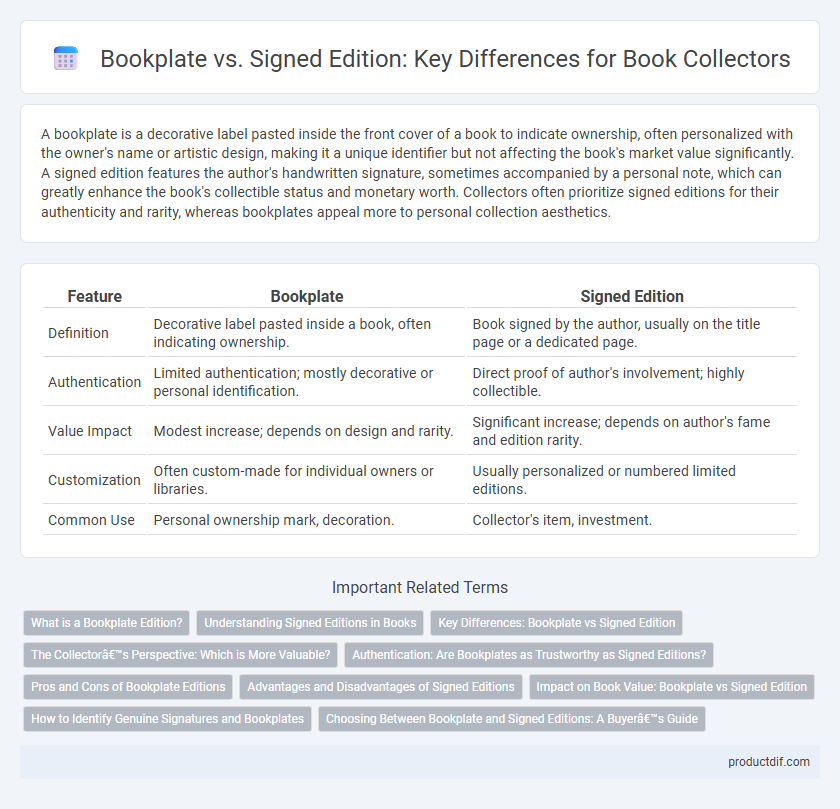A bookplate is a decorative label pasted inside the front cover of a book to indicate ownership, often personalized with the owner's name or artistic design, making it a unique identifier but not affecting the book's market value significantly. A signed edition features the author's handwritten signature, sometimes accompanied by a personal note, which can greatly enhance the book's collectible status and monetary worth. Collectors often prioritize signed editions for their authenticity and rarity, whereas bookplates appeal more to personal collection aesthetics.
Table of Comparison
| Feature | Bookplate | Signed Edition |
|---|---|---|
| Definition | Decorative label pasted inside a book, often indicating ownership. | Book signed by the author, usually on the title page or a dedicated page. |
| Authentication | Limited authentication; mostly decorative or personal identification. | Direct proof of author's involvement; highly collectible. |
| Value Impact | Modest increase; depends on design and rarity. | Significant increase; depends on author's fame and edition rarity. |
| Customization | Often custom-made for individual owners or libraries. | Usually personalized or numbered limited editions. |
| Common Use | Personal ownership mark, decoration. | Collector's item, investment. |
What is a Bookplate Edition?
A Bookplate Edition features a specially designed label affixed inside the front cover, often bearing the author's signature or a unique design that personalizes the book without altering its original printing. This edition allows collectors to own a signed or limited version without the rarity and higher cost of a fully autographed book. Bookplate editions combine the appeal of author-signed memorabilia with the accessibility of standard published copies, enhancing the book's collectible value.
Understanding Signed Editions in Books
Signed editions in books often feature the author's autograph, enhancing their collectible value and providing a personal connection for readers and collectors alike. Unlike bookplates, which are adhesive labels bearing ownership marks or dedications, signed editions are directly inscribed by the author, often including personalized messages or limited edition numbering. This direct authentication increases the book's rarity and appeal in the rare book market, distinguishing signed editions as prized collectibles.
Key Differences: Bookplate vs Signed Edition
Bookplates are decorative labels affixed inside a book to indicate ownership, often personalized with artistic designs or the owner's name, while signed editions feature the author's handwritten signature directly on the book's title page or a dedicated page. Bookplates typically do not add significant monetary value, whereas signed editions are highly sought after by collectors and can substantially increase a book's market worth. The key difference lies in the presence of the author's authentic signature in signed editions versus the ownership identification function of bookplates.
The Collector’s Perspective: Which is More Valuable?
Book collectors often weigh the value of bookplates against signed editions, with signed editions typically commanding higher prices due to their direct authorial association and rarity. A signed edition provides a unique personal connection and provenance that enhances its desirability and market value in collecting circles. Bookplates, while adding a decorative and historical element, usually do not increase a book's worth as significantly as an author's authentic signature.
Authentication: Are Bookplates as Trustworthy as Signed Editions?
Bookplates serve as a form of authentication by linking a book to its owner through personalized labels, but they lack the direct authorial connection found in signed editions. Signed editions provide tangible proof of authenticity and provenance, often increasing a book's value due to the author's direct involvement. While bookplates offer sentimental or collectible value, signed editions remain the more reliable standard for verifying a book's authenticity.
Pros and Cons of Bookplate Editions
Bookplate editions offer a cost-effective alternative to signed editions by allowing authors to pre-sign labels that are later affixed to the book, maintaining authenticity at a lower price point. However, bookplate editions may lack the unique, personal touch of an autograph directly on the book's page, which can impact collectors' perceived value. While bookplates provide convenience and consistency for large print runs, they may not hold the same rarity or desirability as hand-signed editions in the collector's market.
Advantages and Disadvantages of Signed Editions
Signed editions offer unique value by providing a personal connection to the author, often increasing a book's collectible worth. However, signed copies can be more expensive and sometimes suffer from decreased accessibility due to limited availability. While a bookplate allows personalization without altering the original edition, signed editions remain preferable for collectors seeking authenticity and exclusivity.
Impact on Book Value: Bookplate vs Signed Edition
Bookplates generally have a modest impact on a book's value, serving as decorative markers of ownership without significantly increasing market price. Signed editions, especially those with authentic inscriptions from the author, often enhance a book's value substantially due to their rarity and collector appeal. The presence of a signature tends to attract serious collectors and can elevate a book's market demand and resale price far beyond that of a bookplate.
How to Identify Genuine Signatures and Bookplates
To identify genuine signatures and bookplates, examine the ink's texture and consistency under magnification, ensuring it is not mechanically reproduced or printed. Authentic bookplates often bear intricate, engraved designs with a tactile quality, while genuine signatures display natural hand movements and variable pressure. Comparing the signature to known exemplars and verifying provenance with reputable sources further confirms authenticity.
Choosing Between Bookplate and Signed Editions: A Buyer’s Guide
Selecting between bookplates and signed editions hinges on personal preference and collection goals; bookplates offer a customizable, affordable way to personalize books, while signed editions provide authentic author signatures that enhance value and rarity. Collectors seeking a guaranteed autograph usually prefer signed editions for their direct connection to the author, whereas bookplates appeal to those valuing aesthetics and affordability. Understanding factors like authenticity, cost, and intended display helps buyers make an informed decision tailored to their literary investment or enjoyment.
Bookplate vs Signed Edition Infographic

 productdif.com
productdif.com